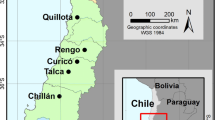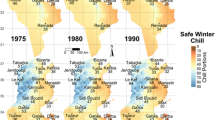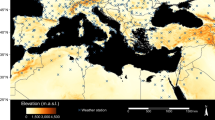Abstract
Fruit production systems that rely on winter chill for breaking of dormancy might be vulnerable to climatic change. We investigated decreases in the number of winter chilling hours (0–7.2°C) in four mountain oases of Oman, a marginal area for the production of fruit trees with chilling requirements. Winter chill was calculated from long-term hourly temperature records. These were generated based on the correlation of hourly temperature measurements in the oases with daylength and daily minimum and maximum temperatures recorded at a nearby weather station. Winter chill was estimated for historic temperature records between 1983 and 2008, as well as for three sets of synthetic 100-year weather records, generated to represent historic conditions, and climatic changes likely to occur within the next 30 years (temperatures elevated by 1°C and 2°C). Our analysis detected a decrease in the numbers of chilling hours in high-elevation oases by an average of 1.2–9.5 h/year between 1983 and 2008, a period during which, according to the scenario analysis, winter chill was sufficient for most important species in most years in the highest oasis. In the two climate change scenarios, pomegranates, the most important tree crop, received insufficient chilling in 13% and 75% of years, respectively. While production of most traditional fruit trees is marginal today, with trees barely fulfilling their chilling requirements, such production might become impossible in the near future. Similar developments are likely to affect other fruit production regions around the world.
Article PDF
Similar content being viewed by others
Avoid common mistakes on your manuscript.
References
Baldocchi D, Wong S (2008) Accumulated winter chill is decreasing in the fruit growing regions of California. Clim Change 87:S153–S166
Bennett JP (1949) Temperature and bud rest period. Calif Agric 3:9, 12
Bertrand A, Prevost D, Bigras FJ, Lalande R, Tremblay GF, Castonguay Y, Belanger G (2007) Alfalfa response to elevated atmospheric CO2 varies with the symbiotic rhizobial strain. Plant Soil 301:173–187
Blanke MM (2008) Perspectives of fruit research and apple orchard management in Germany in a changing climate. Acta Hort 772:441–446
Buerkert A, Nagieb M, Siebert S, Khan I, Al-Maskri A (2005) Nutrient cycling and field-based partial nutrient balances in two mountain oases of Oman. Field Crops Res 94:149–164
Cannell MGR, Grace J, Booth A (1989) Possible impacts of climatic warming on trees and forests in the United Kingdom – a review. Forestry 62:337–364
Easterling DR, Horton B, Jones PD, Peterson TC, Karl TR, Parker DE, Salinger MJ, Razuvayev V, Plummer N, Jamason P, Folland CK (1997) Maximum and minimum temperature trends for the globe. Science 277:364–367
Erez A, Couvillon GA (1987) Characterization of the influence of moderate temperatures on rest completion in peach. J Am Soc Hortic Sci 112:677–680
Erez A, Couvillon GA, Hendershott CH (1979) Quantitative chilling enhancement and negation in peach buds by high-temperatures in a daily cycle. J Am Soc Hortic Sci 104:536–540
Estrella N, Sparks TH, Menzel A (2007) Trends and temperature response in the phenology of crops in Germany. Glob Chang Biol 13:1737–1747
Fisher M (1994) Another look at the variability of desert climates, using examples from Oman. Glob Ecol Biogeogr Lett 4:79–87
Gebauer J, Luedeling E, Hammer K, Nagieb M, Buerkert A (2007) Mountain oases in northern Oman: An environment for evolution and in situ conservation of plant genetic resources. Genet Resour Crop Evol 54:465–482
Hanratty MP, Stefan HG (1998) Simulating climate change effects in a Minnesota agricultural watershed. J Environ Qual 27:1524–1532
IPCC (2007) Climate change 2007: synthesis report. In: Contribution of working groups I, II and III to the fourth assessment report of the intergovernmental panel on climate change. IPCC, Geneva, p 104
Kim SH, Gitz DC, Sicherb RC, Baker JT, Timlin DJ, Reddy VR (2007) Temperature dependence of growth, development, and photosynthesis in maize under elevated CO2. Environ Exp Bot 61:224–236
Kozlowski TT, Pallardy SG (2002) Acclimation and adaptive responses of woody plants to environmental stresses. Bot Rev 68:270–334
Krishnan P, Swain DK, Bhaskar BC, Nayak SK, Dash RN (2007) Impact of elevated CO2 and temperature on rice yield and methods of adaptation as evaluated by crop simulation studies. Agric Ecosyst Environ 122:233–242
Linsley-Noakes GC, Allan P (1994) Comparison of 2 models for the prediction of rest completion in peaches. Sci Hortic 59:107–113
Liverman DM, Terjung WH, Hayes JT, Mearns LO (1986) Climatic change and grain corn yields in the North-American Great Plains. Clim Change 9:327–347
Lobell DB, Bonfils C, Duffy PB (2007) Climate change uncertainty for daily minimum and maximum temperatures: A model inter-comparison. Geophys Res Lett 34:L05715.1–L05715.5
Lobell DB, Field CB, Cahill KN, Bonfils C (2006) Impacts of future climate change on California perennial crop yields: Model projections with climate and crop uncertainties. Agric For Meteorol 141:208–218
Lüdders P, Wernke M (2003) Probleme des Kern- und Steinobstanbaus in tropischen Hochlagen Kolumbiens unter besonderer Berücksichtigung des Kältebedürfnisses der Bäume—Problems of pome and stone fruit trees in the highlands of Columbia with special reference to their chilling requirement. Erwerbsobstbau 45:125–134
Luedeling E, Buerkert A (2008a) Effects of land use changes on the hydrological sustainability of mountain oases in northern Oman. Plant Soil 304:1–20
Luedeling E, Buerkert A (2008b) Typology of mountain oases in Oman based on Landsat and SRTM imagery and geological survey data. Remote Sens Environ 113:1181–1195
Marhan S, Derain D, Erbs M, Kuzyakov Y, Fangmeier A, Kandeler E (2008) Soil organic matter mineralization and residue decomposition of spring wheat grown under elevated CO2 atmosphere. Agric Ecosyst Environ 123:63–68
NCDC (2008) Global surface summary of the day data, ver 7. National Climatic Data Center (NCDC) of the National Oceanic and Atmospheric Administration (NOAA), Asheville
Noel D (2007) Australasian tree crops sourcebook. http://www.wanatca.org.au/atcros/LF.htm. Accessed 09 July 2007
Rea R, Eccel E (2006) Phenological models for blooming of apple in a mountainous region. Int J Biometeorol 51:1–16
Richardson EA, Seeley SD, Walker DR (1974) A model for estimating the completion of rest for Redhaven and Elberta peach trees. Hortscience 9:331–332
Ruiz D, Campoy JA, Egea J (2007) Chilling and heat requirements of apricot cultivars for flowering. Environ Exp Bot 61:254–263
Schäper W (2006) Telescopic eyeglasses and model airplanes. In Practice Innovation 17:2–13
Schneider SH (1977) Climate change and world predicament—case-study for interdisciplinary research. Clim Change 1:21–43
Scholz F (1984) Höhensiedlungen am Jabal Akhdar—Tendenz und Probleme der Entwicklung einer peripheren Region im Oman-Gebirge. ZfWG 28:16–30
Seguin B (2003) Adaptation of agricultural production systems to climatic change. C R Geosci 335:569–575
Semenov MA (2008) Simulation of extreme weather events by a stochastic weather generator. Clim Res 35:203–212
Shaltout AD, Unrath CR (1983) Rest completion prediction model for Starkrimson Delicious apples. J Am Soc Hortic Sci 108:957–961
Vincent LA, Peterson TC, Barros VR, Marino MB, Rusticucci M, Carrasco G, Ramirez E, Alves LM, Ambrizzi T, Berlato MA, Grimm AM, Marengo JA, Molion L, Moncunill DF, Rebello E, Anunciacao YMT, Quintana J, Santos JL, Baez J, Coronel G, Garcia J, Trebejo I, Bidegain M, Haylock MR, Karoly D (2005) Observed trends in indices of daily temperature extremes in South America 1960–2000. J Clim 18:5011–5023
Vose RS, Easterling DR, Gleason B (2005) Maximum and minimum temperature trends for the globe: an update. Geophys Res Lett 32:L23822
Walker NJ, Schulze RE (2008) Climate change impacts on agro-ecosystem sustainability across three climate regions in the maize belt of South Africa. Agric Ecosyst Environ 124:114–124
Weinberger JH (1950) Chilling requirements of peach varieties. Proc Am Soc Hortic Sci 56:122–128
Xiao GJ, Zhang Q, Yao YB, Yang SM, Wang RY, Xiong YC, Sun ZJ (2007) Effects of temperature increase on water use and crop yields in a pea-spring wheat-potato rotation. Agric Water Manag 91:86–91
Zhang XB, Aguilar E, Sensoy S, Melkonyan H, Tagiyeva U, Ahmed N, Kutaladze N, Rahimzadeh F, Taghipour A, Hantosh TH, Albert P, Semawi M, Ali MK, Al-Shabibi MHS, Al-Oulan Z, Zatari T, Khelet IA, Hamoud S, Sagir R, Demircan M, Eken M, Adiguzel M, Alexander L, Peterson TC, Wallis T (2005) Trends in Middle East climate extreme indices from 1950 to 2003. J Geophys Res-Atmos 110:D22104
Zheng X, Basher RE, Thompson CS (1997) Trend detection in regional-mean temperature series: maximum, minimum, mean, diurnal range and SST. J Clim 10:317–326
Author information
Authors and Affiliations
Corresponding author
Rights and permissions
Open Access This is an open access article distributed under the terms of the Creative Commons Attribution Noncommercial License (https://creativecommons.org/licenses/by-nc/2.0), which permits any noncommercial use, distribution, and reproduction in any medium, provided the original author(s) and source are credited.
About this article
Cite this article
Luedeling, E., Gebauer, J. & Buerkert, A. Climate change effects on winter chill for tree crops with chilling requirements on the Arabian Peninsula. Climatic Change 96, 219–237 (2009). https://doi.org/10.1007/s10584-009-9581-7
Received:
Accepted:
Published:
Issue Date:
DOI: https://doi.org/10.1007/s10584-009-9581-7




